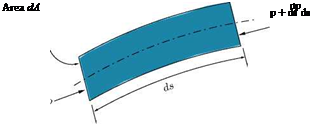Isentropic Flow
The fundamental equations for isentropic flows can be derived by considering a simplified model of a one-dimensional flow field, as follows.
Consider a streamtube differential in equilibrium in a one-dimensional flow field, as represented by the shaded area in Figure 9.1. p is the pressure acting at the left face of the streamtube and (p + ||ds) is the pressure at the right face. Therefore, the pressure force in positive s-direction, Fp, is given by:
dp dp
Fp = p dA — p + ds dA = — ds dA.
ds ds
For equilibrium, dm (dV/dt) = sum of all the forces acting on the streamtube differential, where dm is the mass of fluid in the streamtube element considered, and dV/dt is the substantial acceleration.
|
dV |
dV |
|
|
dV = |
dt + |
ds |
|
dt |
ds |
|
|
dV |
dV dt |
dV ds |
|
— = |
— — + |
— — |
|
dt |
dt dt |
ds dt |
In the above equation for substantial acceleration, dV/dt is the local acceleration or acceleration at a point,
dV ds dV
that is, change of velocity at a fixed point in space with time. The convective acceleration——– = V —
ds dt ds
is the acceleration between two points in space, that is, change of velocity at a fixed time with space. It is present even in a steady flow.
The substantial derivative is expressed as:
![]() dV dV dV
dV dV dV
= + V.
dt dt ds
Therefore, the equilibrium equation becomes:
dp dV
 |
— ds dA = dm. ds dt
But dm = p dA ds. Substituting this into the above equation, we get:
dV _ 1 dp
dt p ds
that is:
Equation (9.13) is applicable for both compressible and incompressible flows; the only difference comes in solution. For steady flow, Equation (9.13) becomes:
![]() dV 1 dp
dV 1 dp
V— + – — = 0.
ds p ds
Integration of Equation (9.14) yields:
 (9.15)
(9.15)
This equation is often called the compressible form of Bernoulli’s equation for inviscid flows. If p is expressible as a function of p only, that is, p = p(p), the second expression is integrable. Fluids having these characteristics, namely the density is a function of pressure only, are called barotropic fluids. For isentropic flow process:
|
p _ |
constant |
(9.16) |
|
pY = |
/ 1/Y |
|
|
p2 _ I |
El |
(9.17) |
|
p1 ‘ |
kpJ ’ |
where subscripts 1 and 2 refer to two different states. Therefore, integrating dp/p between pressure limits p1 and p2 , we get:
Using Equation (9.18), Bernoulli’s equation can be written as:
Equation (9.19) is a form of energy equation for isentropic flow process of gases.
For an adiabatic flow of perfect gases, the energy equation can be written as:
![]()
|
|
|
y P2 v[ = y pi
![]() Y – 1 P2 2 y – 1 Pi 2
Y – 1 P2 2 y – 1 Pi 2
|
|
|
|
|
|
|
|
|
|
|
|
|
|
|
|
|
|
|
|
|
|











